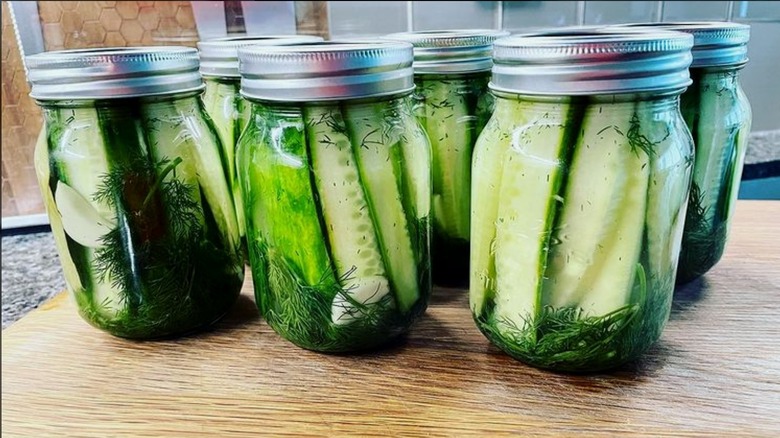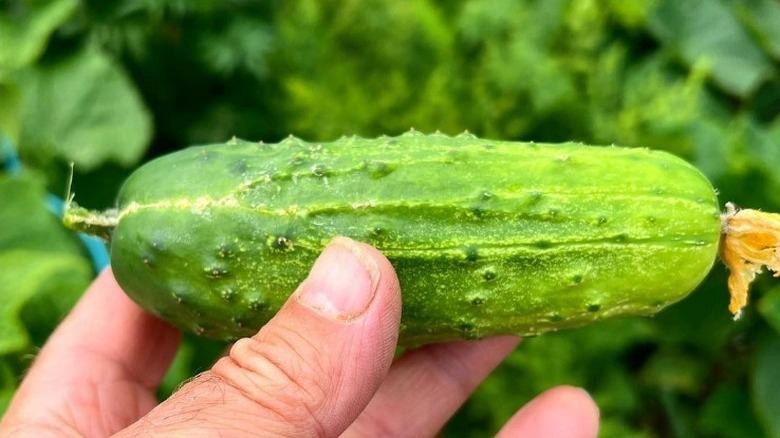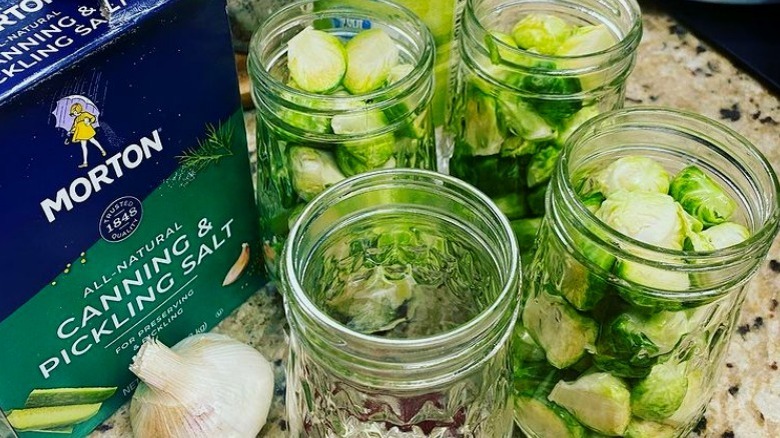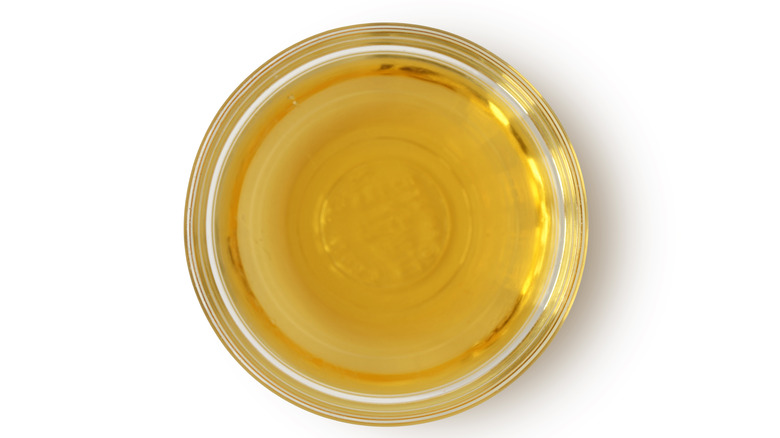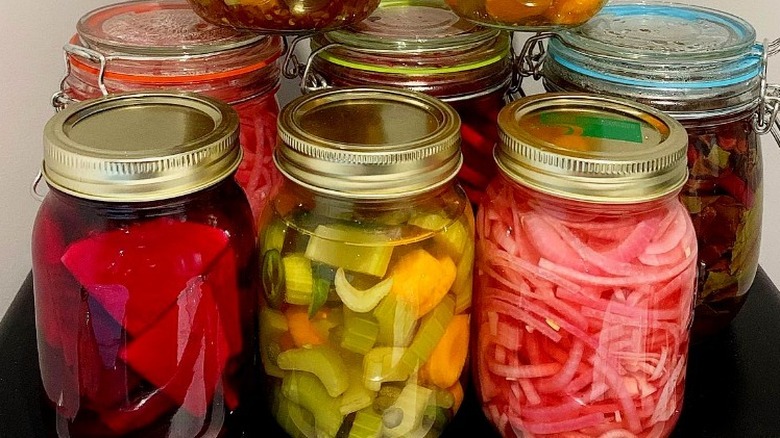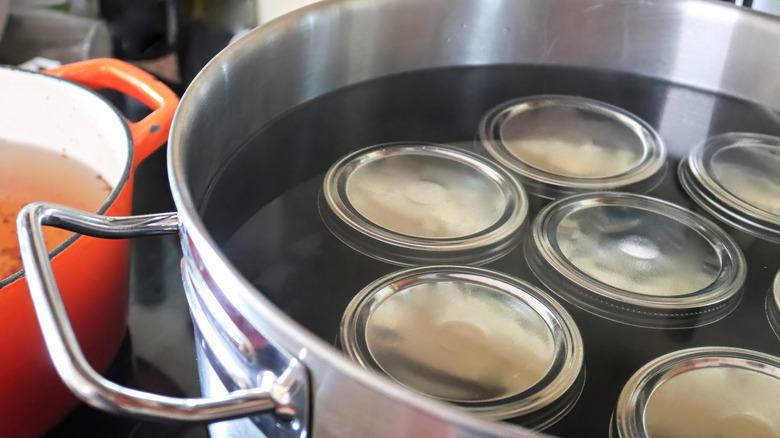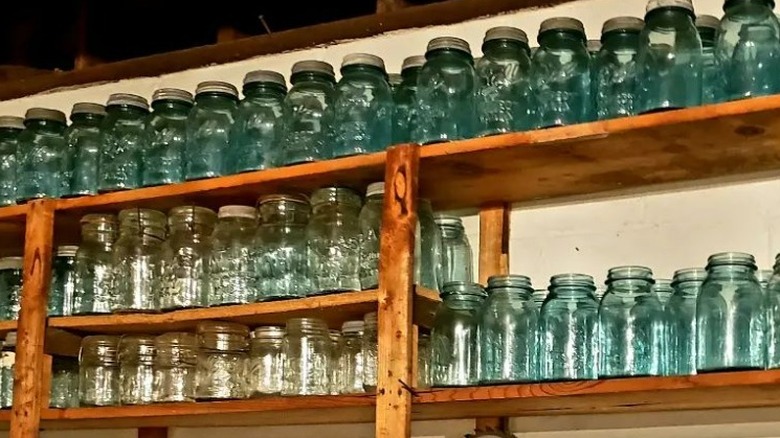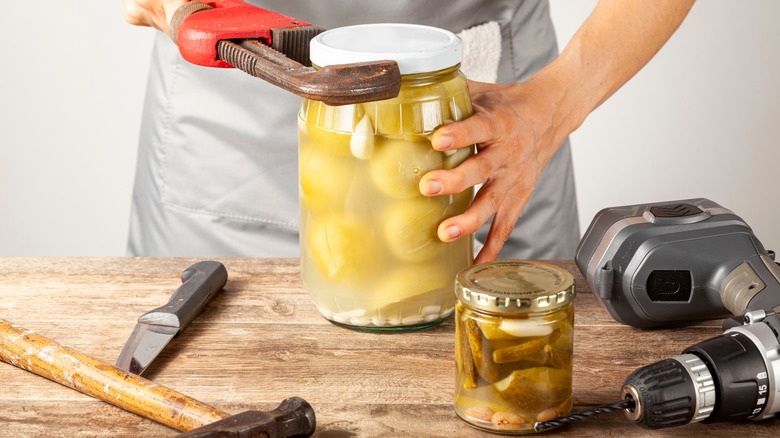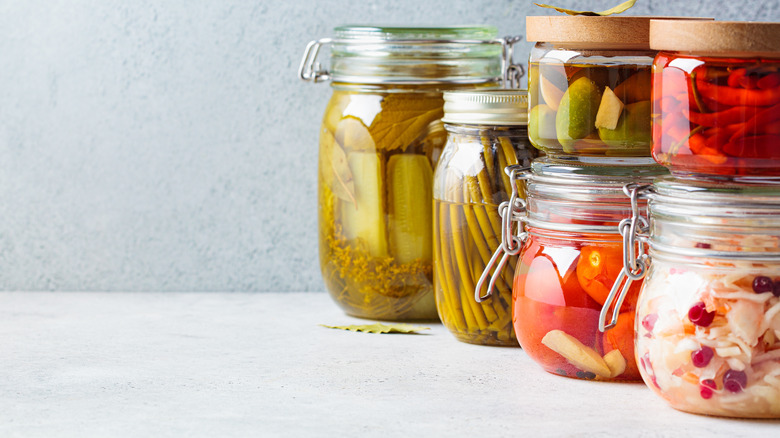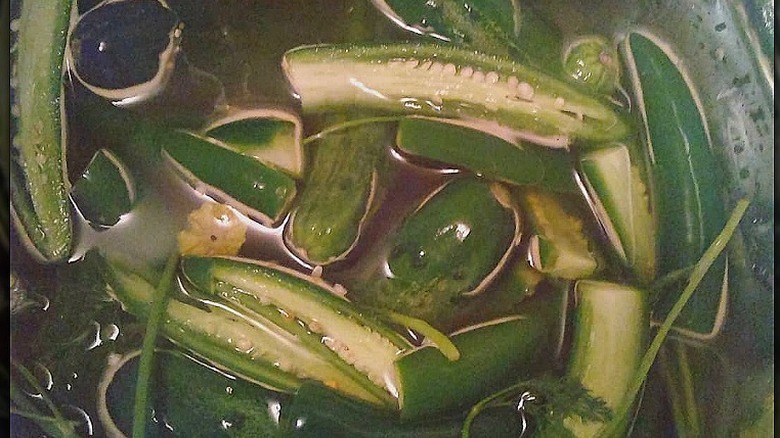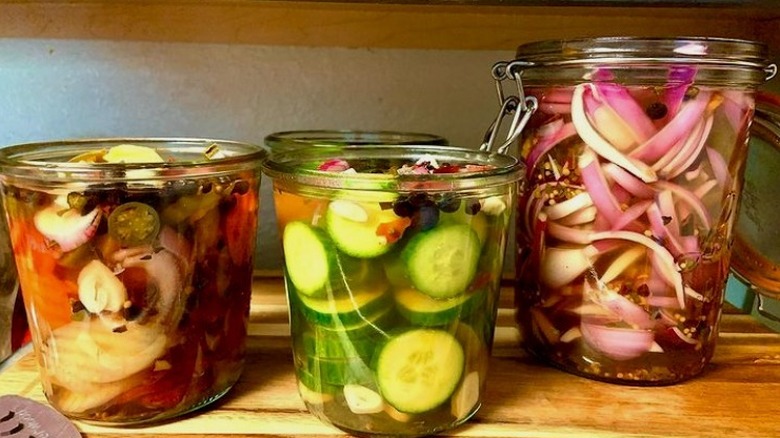10 Mistakes Everyone Makes When Making Pickles
We've been enjoying pickles far before the idea of a refrigerator was ever conceived. According to PBS' "The History Kitchen," pickles are a cross-cultural, globe-trotting method of food preservation dating all the way to 2030 BC. As a way to stretch out food supplies through cold winters or a long journey at sea, pickling is simply the method of sealing vegetables in a brine made of vinegar, water, and salt. Today, we continue to pickle less out of a need to store foodstuffs for a brutal snowstorm, and more from how pickling changes the texture, smell, and flavor of fruits and vegetables. A pickled cucumber has a snap and a crunch on the outside, but with a flesh that is soft, pliable, and deeply infused with added herbs and spices like dill. Change the brine to something sweeter, and you've got ingredients for homemade relish.
Pickling is something you can easily do at home with the right ingredients and equipment. While you shouldn't be intimidated by the work involved and can rest assured that the delicious results are worth the effort, the details do matter when it comes to pickling. So before you whip up your first brine, make sure you're not glossing over these easy-to-miss mistakes.
Not picking the right cucumbers
Those big thick cucumbers might be great in a salad, but they are not so great for pickling unless you happen to own a large wooden barrel. Sticking to a smaller, more uniform size and emphasizing freshness are key to finding good pickling cucumbers. Pickiness pays off according to Bon Appėtit, as you'll want your cucumbers to ferment more evenly for best results. You'll want the right amount of fresh — not too young, but not too old, either.
Remember that cucumbers are going to be held up in a sealed jar filled with an acidic brine for weeks at a time. If they're misshapen, or too large, the brine can leave the inside flesh hallowed out. Too thick a skin and the brine won't be able to penetrate, robbing your pickles of texture and flavor. Do the research and find what cucumbers pickle the best, such as the popular Kirby variety. But make very sure that any cucumbers you bring home are fresh, roughly the same size and length, and that you're ready to pickle very soon. The sooner you get them jarred, the better they'll turn out.
Wrong choice of salt
If the first thing you're looking to grab for your brine is either iodized, sea, or Kosher salt, then stop yourself. While they might add flavor and are great with cooking, your usual table salts won't cut it when it comes to pickling. Allrecipies says to specifically use pickling salt, also called canning or preserving salt. Pickling salt is just pure sodium chloride with no additives and is fine enough to quickly and fully dissolve in water. This is exactly what you need for pickling brine, as additives found in iodized salt can alter factors like the color or taste during the fermentation process.
Kosher salt is the only suitable substitution for pickling salt, and even then it needs to have no additives — not even an anti-caking agent. If you do use Kosher salt, make sure you measure by weight per volume. Since it's more coarse, Kosher salt will take longer to fully dissolve in water. So it typically requires about 50% more Kosher salt to equate to the same amount of pickling salt.
Wrong choice of vinegar
As salt makes up the dry base for pickling brine, vinegar is the wet. But don't assume that any store bought vinegar makes for good brine. The most important factor in vinegar when pickling is the acidity, as this serves as a preserving agent during fermentation. While there are products out there that have "pickling vinegar," on the label, a fast and easy rule when sourcing out your vinegar is to select one with a minimum of 5% acidity.
According to Healthy Canning, both white distilled vinegar and apple cider vinegar contain 5% acidity, as do most labeled and flavored "pickling vinegar." Distilled white vinegar in particular makes for good pickling, as it contains no other additives or flavors that could affect the brine and thus your pickles. Distilled white vinegar is also a solid base for you to infuse whichever spices and herbs you'd like for your pickles. Just keep in mind that depending on how much brine you're making, make sure not to add too much water, as it will dilute the acidity.
Not sterilizing your pickling jars
Pickling requires fermentation to take place, meaning that the inside of your pickling jar needs to not only be clean but sterilized like a surgeon's tools. The vinegar is meant to block the further invasion of pathogens, but an entire jar of pickles can be easily ruined by stray microbes still inside the jar, no matter how strong the vinegar is. Without proper sterilization, your pickles will come out spoiled and completely inedible. There are a number of ways to fully sterilize your jars, but all methods follow the same structure; wash them thoroughly with regular soap and really hot water. If you use a dishwasher, just run the cycle without dish detergent.
While it's typical to submerge your jars in a pot of boiling water, One Million Women goes an extra step and asks to place your jars in an oven set to low heat before you boil. Also, as soon as your jars are sterilized get ready to fill them with brine almost immediately, as the longer they're out in the open, the longer they risk contamination. What's also important is to make sure whatever you're pickling is thoroughly washed as well. Even if it says on the bag that it's been washed, do yourself a favor and wash it again just to be sure.
Not sealing the jar properly
Sterilizing and sealing the jars can be one of the more dangerous aspects of pickling, as you'll be working with a lot of hot liquid, so always practice proper safety precautions. Consider using a jar lifter to transport the scalding hot jars safely and securely. Proper pickling requires the seal of the jar to be made as airtight as possible, and the last few steps are crucial to making that happen. If the jar is not air-tight, then the mixture is at greater risk of outside contamination, leading to a ruined batch of pickles. Use metal airtight lids with separate screw-on collars when pickling, but never reuse the lids afterward.
Epicurious states that as you lightly boil your filled and sealed jars, don't over tighten the lids. You want there to be a little bit of room for the last bits of air to be boiled out. After boiling and cooling off, remember to test the air tightness. The vacuum seal at this time should be totally flat. If it has a bump in the center, it's not air-tight, but just pop it in the fridge and you can still eat it in a week.
Not cooling down your jars
An easily overlooked step during processing is allowing your sealed jars to cool off on their own. While the other steps to pickling are on the busier side, here you'll find that patience and maintaining a hands-off mentality will pay off by the end. Cooling down does not mean letting the jars go ice cold, by the way. The jars must be gradually brought down from scalding hot to around room temperature.
Healthy Canning emphasizes the word, "gradual," when it comes to the cool down. Once the allotted boiling time has passed, do not take the jars out immediately. Instead, turn the heat off and let them sit for in the water for at least 5 minutes before removing, moving them to either on a towel or wire rack and away from any cool air. That's where they'll stay, untouched, from 12 to 24 hours. If kept warm for longer than needed, your pickles can develop a flat sour. This occurs when a small amount of bacteria negatively affects the fermentation and saps the brine of flavor. Cooling too fast, however, runs the risk of damaging the seal, and ruining your pickles' airtightness.
Not giving your pickles enough time
Think of pickling as a sort of investment. You put in the time and the labor to pick the cucumbers, make the brine, and finally fill and process the jars. Now all that's left to do is put them in a cool, dry place and wait. If you've done everything correctly, you can kick back and let your concoctions appreciate in value over time. Depending on what kind of pickles you're making, your wait time might take anywhere from a few days to several weeks or a couple of months. But if you want that ideal pickle taste, texture, and soft crunch, then you have to give them the time that they need.
All that resting allows the brine to do its thing and start fermenting, loosening up the cucumbers or vegetables and allowing the spice mixture to permeate the inner flesh. The only ingredient needed to let your pickles rest is lots of patience. You'll be grateful for all that given time once you finally pop the lid.
Not using the right spices
Aside from achieving preservation without the use of refrigeration, the real genius of the pickle brine is that it acts as a blank canvas for all sorts of flavors you can infuse into your pickles. Just remember to pair the right set of spices with the kind of vegetable you'd like to pickle and consider what flavors you're looking for. Also, use whole herbs and spices when you can, as it results in better infusion. For classic pickles, sprigs of dill is the herb of choice. But don't be afraid to try adding mustard seeds, garlic, and some sugar to offset the harsh vinegar taste.
The Exploritorium recommends against using powered spices, as these cloud up and darken the water, obscuring a clear vision to observe the progress of your pickling. Your whole spices should also be tied together, preferably wrapped in cheese cloth as opposed to anything with colors or dyes that can bleed into the brine. There are almost too many spice combinations to name for pickling, but you can purchase a pre-made spice mix or make it homemade.
Not correctly measuring your brine ingredients
It's one thing to not have enough brine for all the pickles you'd like to make. But it's way worse if you haven't measured out just how much of each of your main ingredients goes into your brine. Your brine isn't just there to add flavor; it's your only protection from spoiling. According to Mountain Feed and Farm Supply, a solid rule is 2 parts vinegar for every 1 part of water, as this ratio allows the vinegar base of your brine to maintain a strong enough level of acidity to maintain its preserving properties. Regarding salt, Serious Eats recommends 1 cup of salt with each gallon of water and 3 quarts of vinegar.
Traditionally, if you're making pickles, you're making a lot at once. But if you're going for a smaller batch, remember to scale down your measurements. Getting your measurements right means every part of the brine will do its job properly and give you the tasty, fresh pickles that you're craving.
Pickling several different vegetables in one jar
Pickling isn't just regulated to cucumbers — quite the opposite. There's a very literal cornucopia of vegetables and fruits, and even proteins like meat, fish, eggs, and tofu that you can pickle in different ways. The mistake is thinking that you can simply throw a few cucumbers, crowns of cauliflower, and slices of onion into one jar and call it a day. Even if you'd like the same flavor from several different pickled vegetables, it's still a good call to jar them separately.
Every vegetable has different qualities that need to be considered while pickling. Even if the same brine is used, it might take more or less time to reach the perfect state of, "doneness." Different vegetables fermenting at different rates could throw off the normal pickling time for the entire jar. If crammed and fermented together, you risk opening a jar only to find most of what's inside hasn't finished pickling. While it is a little extra work, separate jarring helps equalize that process and makes it easier for you to know when it's the right time to pop the lid.
